
Gouramis, or gouramies, are a group of freshwater anabantiform fish that comprise the family Osphronemidae. The fish are native to Asia—from the Indian Subcontinent to Southeast Asia and northeasterly towards Korea. The name "gourami", of Indonesian origin, is also used for fish of the families Helostomatidae and Anabantidae.
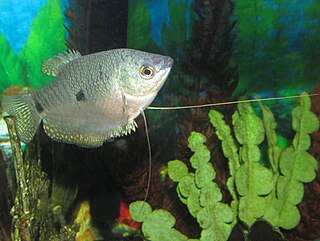
The three spot gourami, also known as the opaline gourami, blue gourami, and gold gourami, is a species of fish native to southeastern Asia, but also introduced elsewhere. This gourami gets its name from the two spots along each side of its body in line with the eye, considered the third spot. This species is of minor commercial importance as a food fish in its native range and is also farmed. It is also popular in the aquarium trade. The species reaches 15 cm in standard length.
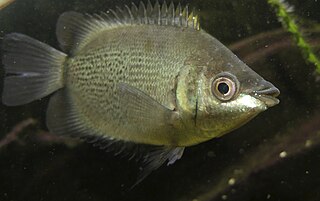
Kissing gouramis, also known as kissing fish or kissers, are medium-sized tropical freshwater fish comprising the monotypic labyrinth fish family Helostomatidae. These fish originate from Mainland Southeast Asia, the Greater Sundas and nearby smaller islands, but have also been introduced outside their native range. They are regarded as a food fish and they are sometimes farmed. They are used fresh for steaming, baking, broiling, and pan frying. The kissing gourami is a popular aquarium fish.

The fork tailed paradisefish, or paradise gourami is a species of gourami found in most types of fresh water in East Asia, ranging from the China to northern Vietnam. This species can reach a standard length of 6.7 cm, though most are only about 5.5 cm . Paradise gouramis were one of the first ornamental fish available to western aquarium keepers, having been imported 1869 to France by the French aquarium fish importer Pierre Carbonnier in Paris. The paradise fish is one of the more aggressive members of its family. It is more aggressive than the three spot gourami, yet less pugnacious in nature than the less commonly kept combtail.
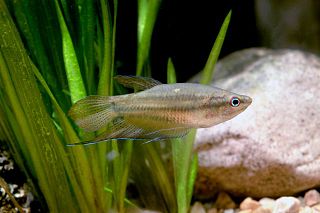
The croaking gourami is a species of small freshwater labyrinth fish of the gourami family. They are native to still waters in Southeast Asia and are distributed worldwide via the aquarium trade. Croaking gouramis are capable of producing a "croaking" noise using their pectoral fins.

The pygmy gourami, also known as the sparkling gourami, is a freshwater species of gourami native to Southeast Asia.
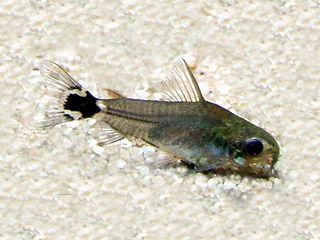
The dwarf corydoras, dwarf catfish, tail spot pygmy catfish, or micro catfish is a tropical freshwater fish belonging to the subfamily Corydoradinae of the family Callichthyidae. It originates in inland waters in South America, and is found in the Amazon River and Paraguay River basins in Argentina, Bolivia, and Brazil. The specific epithet hastatus means with a spear, in reference to the spearhead-like spot on the tail root.

The Anabantoidei are a suborder of anabantiform ray-finned freshwater fish distinguished by their possession of a lung-like labyrinth organ, which enables them to breathe air. The fish in the Anabantoidei suborder are known as anabantoids or labyrinth fish, or colloquially as gouramies. Some labyrinth fish are important food fish, and many others, such as the Siamese fighting fish and paradise fish, are popular as aquarium fish.

The lemon tetra is a species of tropical freshwater fish which originates from South America, belonging to the family Characidae. It is a small tetra growing to 5 cm (2 in) in length. The species is a long established favourite aquarium fish, being introduced to the aquarium in 1932.

Hemigrammus erythrozonus, commonly known as the glowlight tetra, is a small tropical fish from the Essequibo River, Guyana, South America. It is silver in colour and a bright iridescent orange to red stripe extends from the snout to the base of its tail, the front of the dorsal fin being the same color as the stripe. Other fins are silver to transparent. The glowlight tetra is a peaceful, shoaling fish. It is larger than the neon tetra, and its peaceful disposition makes it an ideal, and popular, community tank fish. It should be kept with similar sized, non-aggressive species. Hemigrammus gracilis is a senior synonym. The red-line rasbora of Malaysia and Indonesia has markings and coloring very similar to H. erythrozonus, but is a member of family Cyprinidae, not a close relative.
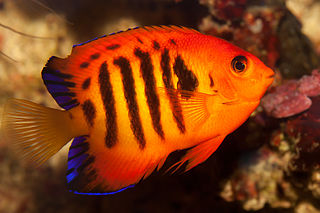
The flame angelfish is a marine angelfish of the family Pomacanthidae found in tropical waters of the Pacific Ocean. Other common names include flame angel, flaming angelfish and Japanese pygmy angelfish.

The thick-lipped gourami is a species of gourami native to Southeast Asia, and is a popular aquarium fish.

The moonlight gourami, also known as the moonbeam gourami, is a labyrinth fish of the family Osphronemidae native to Indochina. This peaceful species is a popular aquarium fish.

The snakeskin gourami is a species of gourami native to Southeast Asia. Prior to the merging of Belontidae to the family Osphronemidae, the snakeskin gourami was regarded as the largest member of its family. It is still the largest species in its genus and subfamily.

Betta pallifina is a species of gourami endemic to the island of Borneo.

The honey gourami is a species of gourami native to India and Bangladesh.

The violet goby is a species of goby native to marine, fresh and brackish waters near the Atlantic coast of North and South America from South Carolina in the United States of America, to northern Brazil. It prefers bays, estuaries and river mouths with muddy substrates. It is often marketed as the dragon goby or dragon fish.

Trichogaster fasciata, the banded gourami or striped gourami or Colisa or Kholshe, is a tropical labyrinth perch found in some Asian countries like Bangladesh, Eastern India, Northeastern India, Nepal, Upper Myanmar, China and Pakistan.
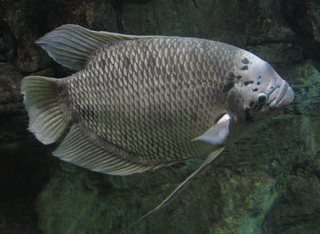
The giant gourami is a species of large gourami native to freshwater habitats in Southeast Asia. It has also been introduced elsewhere. The species is commercially important as a food fish and is also farmed. It can be found in the aquarium trade, as well. The species has been used for weed control on highly invasive aquatic plants like Salvinia molesta, as the giant gourami can be a voracious herbivore.

Betta pi is a species of gourami belonging to the genus Betta. It is found in the Pru Toe-Daeng peat swamps in Narathiwat Province in Southern Thailand, but its range also extends into northern Peninsular Malaysia, most notably the states of Kelantan and Terengganu. It is primarily found in well-shaded peat forest blackwater swamps and creeks where the pH can be as low as 3.0 or 4.0. It is benthopelagic. It can grow to a maximum length of 9.0 cm (3.5 in). It is a fish of mild importance in the aquarium industry. Its diet consists of aquatic invertebrates in the wild, but will also eat frozen, live and dried foods such as larva of Chironomidae, Daphnia, and brine shrimp in aquariums.

























